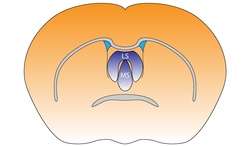Septal area
The septal area (medial olfactory area) is an area in the lower, posterior part of the medial surface of the frontal lobe, and refers to the nearby septum pellucidum.
| Septal area | |
|---|---|
 Lateral and medial septal nuclei in the septal area of the mouse brain | |
| Details | |
| Identifiers | |
| Latin | nuclei septales |
| MeSH | D012686 |
| NeuroNames | 259 |
| TA | A14.1.09.266 |
| FMA | 61845 |
| Anatomical terms of neuroanatomy | |
The septal nuclei are located in this area. The septal nuclei are composed of medium-size neurons which are classified into dorsal, ventral, medial, and caudal groups.[1] The septal nuclei receive reciprocal connections from the olfactory bulb, hippocampus, amygdala, hypothalamus, midbrain, habenula, cingulate gyrus, and thalamus. The septal nuclei are essential in generating the theta rhythm of the hippocampus.
The septal area (medial olfactory area) has no relation to the sense of smell, but it is considered a pleasure zone in animals. The septal nuclei play a role in reward and reinforcement along with the nucleus accumbens. In the 1950s, Olds & Milner showed that rats with electrodes implanted in this area will self-stimulate repeatedly (i.e., press a bar to receive electrical current that stimulate the neurons).[2] Experiments on the septal area of humans have taken place since the 1960s.[3][4][5][6]
Connections

The septal area is located on the lower posterior part of the frontal lobe. The septal area refers to the nearby septum pellucidum. It is located underneath the corpus callosum and in front of the lamina terminalis. The lamina terminalis is a layer of gray matter that connects the optic chiasma and the anterior commissure.[7] The septal nuclei are in the septal area, and are essential in generating the theta rhythm of the hippocampus.[8]
The dorsal septum projects to the lateral preoptic area, lateral hypothalamus, periventricular hypothalamus and midline thalamus.
Fibers from the ventral half of the septum project topographically to the hippocampal formation, thalamus, hypothalamus and midbrain. Specifically, neurons located along the midline in the vertical limb of the diagonal band of Broca project through the dorsal fornix to all CA fields of the dorsal hippocampus and adjacent subicular cortex. Other fibers from this region project through the stria medullaris to the medial and lateral habenular nuclei, the paratenial and anteromedial nucleus of the thalamus, and through the medial forebrain bundle to the pars posterior of the medial mammillary nucleus.
Cells located in the intermediolateral septum also project through the lateral part of the fimbria to all CA fields of the ventral hippocampus and adjacent subicular and entorhinal cortices. These cells also send fibers through the stria medullaris to the lateral habenular nucleus and mediodorsal thalamic nucleus. Other axons arising from these cells descend through the medial forebrain bundle to terminate in a region dorsal to the interpeduncular nucleus.
The lateral septum is a relay center for connections from the CA3 of the hippocampus to the ventral tegmental area. These connections help link reward signals with the context in which they occur.[9]
Fibers from the most lateral part of the ventral septum (i.e., bed nucleus of the anterior commissure) project through the stria terminalis to the ventral subiculum. In addition, cells located in the horizontal limb of the diagonal band project massively to the pars posterior of the medial mammillary nucleus, the ventral tegmental area, and amygdala.
Lateral septum and social behavior
Inhibitory GABA, and excitatory glutamate, which regulate lateral septum (LS) activity, have been found to be increased during social play in juvenile rats. No sex differences were found in extracellular GABA concentrations during social playing, however, glutamate plays a major role in female social playing. When glutamate receptors are blocked in the LS pharmacologically, there is a significant decrease in female social playing, while males had no decrease in playing. This suggests that in the lateral septum, GABA neurotransmission is involved in social play behavior regulation in both sexes, while glutamate neurotransmission is sex-specific, involved in regulation of social play only in female juvenile rats.[10]
References
- St-Amant, Maxime. "Septal nuclei | Radiology Reference Article | Radiopaedia.org". Radiopaedia. Retrieved 23 October 2019.
- Olds J, Milner P (1954). "Positive reinforcement produced by electrical stimulation of septal area and other regions of rat brain". Journal of Comparative and Physiological Psychology. 47 (6): 419–27. doi:10.1037/h0058775. PMID 13233369. Retrieved 17 March 2013.
- Heath RG (1963). "Electrical self-stimulation of the brain in man". The American Journal of Psychiatry. 120 (6): 571–577. doi:10.1176/ajp.120.6.571. ISSN 0002-953X. PMID 14086435.
- Moan CE, Heath RG (1972). "Septal stimulation for the initiation of heterosexual behavior in a homosexual male". Journal of Behavior Therapy and Experimental Psychiatry. 3 (1): 23–30. doi:10.1016/0005-7916(72)90029-8. ISSN 0005-7916.
- Szalavitz, Maia. "Controversial Surgery for Addiction Burns Away Brain's Pleasure Center". Time. ISSN 0040-781X. Retrieved 4 May 2018.
- Zamiska, Nicholas (28 April 2008). "China Bans Irreversible Brain Procedure". Wall Street Journal. ISSN 0099-9660. Retrieved 4 May 2018.
- Gaillard, Frank. "Septal area | Radiology Reference Article | Radiopaedia.org". Radiopaedia. Retrieved 21 October 2019.
- Butler, T (15 August 2014). "Comparison of human septal nuclei MRI measurements using automated segmentation and a new manual protocol based on histology". NeuroImage. 97: 245–51. doi:10.1016/j.neuroimage.2014.04.026. PMC 4180657. PMID 24736183.
- Luo AH, Tahsili-Fahadan P, Wise RA, Lupica CR, Aston-Jones G (14 July 2011). "Linking Context with Reward: A Functional Circuit from Hippocampal CA3 to Ventral Tegmental Area". Science. 333 (6040): 353–357. doi:10.1126/science.1204622. PMC 3150711. PMID 21764750.
- Bredewold R, Schiavo JK, van der Hart M, Verreij M, Veenema AH (2015). "Dynamic changes in extracellular release of GABA and glutamate in the lateral septum during social play behavior in juvenile rats: Implications for sex-specific regulation of social play behavior". Neuroscience. 307: 117–27. doi:10.1016/j.neuroscience.2015.08.052. PMC 4591248. PMID 26318330.